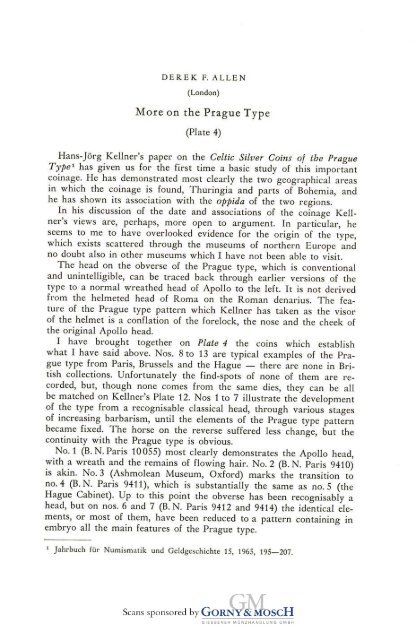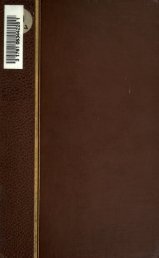- Seite 1 und 2:
JAHRBUCH FUR NUMISMATIK UND GELDGES
- Seite 3:
Jahrbuch für Numismatik und Geldge
- Seite 6 und 7:
Redaktion: Prof. Dr. Konrad Kraft S
- Seite 9 und 10:
HANS VON AULOCK (Istanbul) Zur Silb
- Seite 11 und 12:
Zur Silberprägung des karischen St
- Seite 13 und 14:
Zur Silberprägung des karischen St
- Seite 15 und 16:
Zur Silberprägung des karischen St
- Seite 17:
Zur Silberprägung des karischen St
- Seite 21 und 22:
KONRAD KRAFT (Frankfurt a. M.) Zum
- Seite 23 und 24:
Zum Capricorn auf den Münzen des A
- Seite 25 und 26:
Zum Capricorn auf den Münzen des A
- Seite 27 und 28:
Zum Capricorn auf den Münzen des A
- Seite 29:
7 10 11 12 13 ' 8 4 9 Tafel 2
- Seite 32 und 33:
26 Konrad Kraft Darüberhinaus lä
- Seite 35 und 36:
TILMANN BECHERT (Frankfurt a. M.) Z
- Seite 37 und 38:
Zur Bestimmung eines Sesterz aus de
- Seite 39:
1 2 3 4 5 6 7 8 Tafel 3
- Seite 43 und 44:
Literaturüberblicke der griechisch
- Seite 45 und 46:
Zentralgriechenland 37 AA A JA A JN
- Seite 47 und 48:
HELGA GESCHE (Frankfurt a. M.) Zent
- Seite 49 und 50:
Zentralgriechenland 41 Wie die phok
- Seite 51 und 52: Zentralgriechenland 43 hen. Um die
- Seite 53 und 54: Zentralgriechenland 45 Literaturzus
- Seite 55 und 56: Zentralgriechenland 47 I. Materialv
- Seite 57 und 58: Zentralgriechenland 49 und nicht wi
- Seite 59 und 60: Zentralgriechenland 51 bespricht ei
- Seite 61 und 62: Zentralgriechenland 53 sowie ein we
- Seite 63 und 64: Zentralgriechenland 55 49) Sylloge
- Seite 65 und 66: Zentralgriechenland 57 schen Verban
- Seite 67 und 68: Zentralgriechenland 59 65) A. Posto
- Seite 69 und 70: Zentralgriechenland 61 — Rs.: e)
- Seite 71 und 72: Zentralgriechenland 63 geschaffen,
- Seite 73 und 74: Zentralgriechenland 65 nisse in Del
- Seite 75 und 76: Zentralgriechenland 67 Stateren bzw
- Seite 77 und 78: Zentralgriechenland 69 110) S. N. D
- Seite 79 und 80: Zentralgriechenland 71 birge, das s
- Seite 81 und 82: Zentralgriechenland 73 Frage, was d
- Seite 83 und 84: Zentralgriechenland 75 untersucht a
- Seite 85 und 86: Zentralgriechenland 77 bringt u. a.
- Seite 87 und 88: Zentralgriechenland 79 161) L. Bür
- Seite 89 und 90: Zentralgriechenland 81 173) L. Lacr
- Seite 91 und 92: Zentralgriechenland 83 Ausführlich
- Seite 93 und 94: Zentralgriechenland 85 rantiquite,
- Seite 95 und 96: Zentralgriechenland 87 erwähnt (S.
- Seite 97 und 98: Zentralgriechenland 89 Akerman, J.
- Seite 99 und 100: Zentralgriechenland 91 Villenoisy,
- Seite 101: Zentralgriechenland 93 Oropus 35 Os
- Seite 105: Tafel 4 18 19
- Seite 108 und 109: 98 Derek F. Allen from the south ea
- Seite 111 und 112: NICOLAE LUPU (Sibiu, Rumänien) Asp
- Seite 113 und 114: Aspekte des Münzumlaufs im vorröm
- Seite 115 und 116: Aspekte des Münzumlaufs im vorröm
- Seite 117 und 118: Aspekte des Münzumlaufs im vorröm
- Seite 119 und 120: Aspekte des Münzumlaufs im vorröm
- Seite 121 und 122: Aspekte des Münzumlaufs im vorröm
- Seite 123 und 124: Aspekte des Münzumlaufs im vorröm
- Seite 125 und 126: Aspekte des Münzumlaufs im vorröm
- Seite 127 und 128: Aspekte des Münzumlaufs im vorröm
- Seite 129 und 130: Aspekte des Münzumlaufs im vorröm
- Seite 131: Tafel 5
- Seite 135: 1 Tafel 7 2 4 5 6
- Seite 139 und 140: JUDITA WINKLER (Cluj, Rumänien) Sc
- Seite 141 und 142: Schatzfunde römischer Silbermünze
- Seite 143 und 144: Schatzfunde römischer Silbermünze
- Seite 145 und 146: Schatzfunde römischer Silbermünze
- Seite 147 und 148: Schatzfunde römischer Silbermünze
- Seite 149 und 150: Schatzfunde römischer Silbermünze
- Seite 151 und 152: Schatzfunde römischer Silbermünze
- Seite 153 und 154:
Schatzfunde römischer Silbermünze
- Seite 155 und 156:
Schatzfunde römischer Silbermünze
- Seite 157 und 158:
Schatzfunde römischer Silbermünze
- Seite 159 und 160:
Schatzfunde römischer Silbermünze
- Seite 161:
CnID — *MD *A *i) uapita sive aZI
- Seite 165:
85 80 75 70 65 -.I 60 • 55 Ki 50
- Seite 168 und 169:
146 Judita Winkler 52. Dolj (ehemal
- Seite 170 und 171:
148 Judita Winkler 75. Iyalnija, R.
- Seite 172 und 173:
150 Judita Winkler 102. Pirgäreeti
- Seite 174 und 175:
152 Judita Winkler — Rucär, sieh
- Seite 176 und 177:
154 Judita Winkler 2 von Galba, 1 v
- Seite 178 und 179:
156 Judita Winkler 170. Transilvani
- Seite 180 und 181:
158 Baruch Kanael Die Literaturübe
- Seite 182 und 183:
160 Baruch Kanael INB Israel Numism
- Seite 184 und 185:
162 Baruch Kanael verdächtigen. Be
- Seite 186 und 187:
164 Baruch Kanael Seit dem ersten W
- Seite 188 und 189:
166 Baruch Kanael Doch drang diese
- Seite 190 und 191:
168 Baruch Kanael Die Reihenfolge d
- Seite 192 und 193:
170 Baruch Kanael Hill, Serie E) no
- Seite 194 und 195:
172 Baruch Kanael Bisher ist es noc
- Seite 196 und 197:
174 Baruch Kanael kleineren Münzen
- Seite 198 und 199:
176 Baruch Kanael jüdische Gebiete
- Seite 200 und 201:
178 Baruch Kanael 50 n. Chr. beginn
- Seite 202 und 203:
180 Baruch Kanael auf Landpflegerm
- Seite 204 und 205:
182 Baruch Kanael Die Judaea Capta
- Seite 206 und 207:
184 Baruch Kanael in der Bibel „d
- Seite 208 und 209:
186 Baruch Kanael die Aufständisch
- Seite 210 und 211:
188 Baruch Kanael ersten des Antigo
- Seite 212 und 213:
190 Baruch Kanael Herodianer 37—
- Seite 214 und 215:
192 Baruch Kanael attizierende Silb
- Seite 216 und 217:
194 Baruch Kanael Münzen geprägt
- Seite 218 und 219:
196 Baruch Kanael des Hyrkanus war
- Seite 220 und 221:
198 Baruch Kanael hebräischen Name
- Seite 222 und 223:
200 Baruch Kanael 53) L. Kadm an
- Seite 224 und 225:
202 Baruch Kanael Makkabäer sich d
- Seite 226 und 227:
204 Baruch Kanael alle Münzen dies
- Seite 228 und 229:
206 Baruch Kanael 66) C. L amb er t
- Seite 230 und 231:
208 Baruch Kanael 76) Y. Meshor er,
- Seite 232 und 233:
210 Baruch Kanael Zu den Silbermün
- Seite 234 und 235:
212 Baruch Kanael Satrapen, die hie
- Seite 236 und 237:
214 Baruch Kanael nicht mit einer J
- Seite 238 und 239:
216 Baruch Kanael 96) A. Reifenberg
- Seite 240 und 241:
218 Baruch Kanael Allgemeine Übers
- Seite 242 und 243:
220 Baruch Kanael liege und merkt a
- Seite 244 und 245:
222 Baruch Kanael steuern identisch
- Seite 246 und 247:
224 Baruch Kanael gung an dem Aufst
- Seite 248 und 249:
226 Baruch Kanael Ordnung der Buchs
- Seite 250 und 251:
228 Baruch Kanael sie mit Vorbehalt
- Seite 252 und 253:
230 Baruch Kanael 158) B. Kanael, T
- Seite 254 und 255:
232 Baruch Kanael 161) A. Kindler,
- Seite 256 und 257:
234 Baruch Kanael 2.-4.) Münzen de
- Seite 258 und 259:
236 Baruch Kanael Der Buchstabe A
- Seite 260 und 261:
238 Baruch Kanael 180) G. J. Cheste
- Seite 262 und 263:
240 Baruch Kanael (na) TIBEPIEON sc
- Seite 264 und 265:
242 Baruch Kanael Tiberius 60 Jahre
- Seite 266 und 267:
244 Baruch Kanael pus (--= 19/20 od
- Seite 268 und 269:
246 Baruch Kanael gewöhnlich angen
- Seite 270 und 271:
248 Baruch Kanacl Gratus (15-26 n.
- Seite 272 und 273:
250 Baruch Kanael 221) V.A. Clain-S
- Seite 274 und 275:
252 Baruch Kanael nach Abschluß de
- Seite 276 und 277:
254 Baruch Kanael Auf S. 801 bemerk
- Seite 278 und 279:
256 Baruch Kanael J. Zweiter Aufsta
- Seite 280 und 281:
258 Baruch Kanael 257) P. K a h an
- Seite 282 und 283:
260 Baruch Kanael 263) L. Mildenber
- Seite 284 und 285:
262 Baruch Kanael Aufstandes auf ei
- Seite 286 und 287:
264 Baruch Kanael Das Tempelbild au
- Seite 288 und 289:
266 Baruch Kanael Zusammenfassend m
- Seite 290 und 291:
268 Baruch Kanael Kelch für die Om
- Seite 292 und 293:
270 Baruch Kanael angenommen — di
- Seite 294 und 295:
272 Baruch Kanael Zweiten Tempels m
- Seite 296 und 297:
274 Baruch Kanael und drei des Buch
- Seite 298 und 299:
276 Baruch Kanael 312) S. Raff aeli
- Seite 300 und 301:
278 Baruch Kanael Festsetzung des W
- Seite 302 und 303:
280 Baruch Kanael Ausdrücke auf He
- Seite 304 und 305:
282 Baruch Kanael prägen. Hever Ha
- Seite 306 und 307:
284 Baruch Kanael KAIEAPOE, Rs. NEP
- Seite 308 und 309:
286 Baruch Kanael Das einem Andreas
- Seite 310 und 311:
288 Baruch Kanael 365) J. Germer-Du
- Seite 312 und 313:
290 Baruch Kanael der Höfe wurden
- Seite 314 und 315:
292 Baruch Kanael Die Kasematten de
- Seite 316 und 317:
294 Hacksilber 349 Hadranus 26, 51,
- Seite 318 und 319:
296 Baruch Kanael Tetradrachmen des
- Seite 320 und 321:
298 Baruch Kanael Perowne, S. 202 P
- Seite 322:
GERHARD HIRSCH NUMISMATIKER Verstei

















